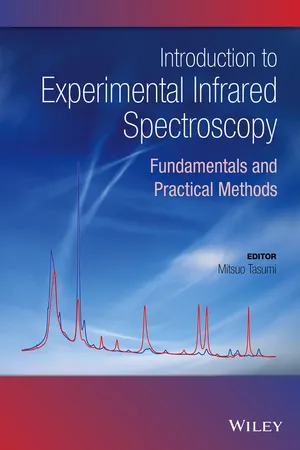
Introduction to Experimental Infrared Spectroscopy
Fundamentals and Practical Methods
- English
- ePUB (mobile friendly)
- Available on iOS & Android
About this book
Infrared spectroscopy is generally understood to mean the science of spectra relating to infrared radiation, namely electromagnetic waves, in the wavelength region occurring intermediately between visible light and microwaves. Measurements of infrared spectra have been providing useful information, for a variety of scientific research and industrial studies, for over half a century; this is set to continue in the foreseeable future.
Introduction to Experimental Infrared Spectroscopy is intended to be a handy guide for those who have no, or limited, experience in infrared spectroscopic measurements but are utilising infrared-related methods for their research or in practical applications.
Written by leading researchers and experienced practitioners, this work consists of 22 chapters and presents the basic theory, methodology and practical measurement methods, including ATR, photoacoustic, IR imaging, NIR, 2D-COS, and VCD. The six Appendices will aid readers in understanding the concepts presented in the main text.
Written in an easy-to-understand way this book is suitable for students, researchers and technicians working with infrared spectroscopy and related methods.
Frequently asked questions
- Essential is ideal for learners and professionals who enjoy exploring a wide range of subjects. Access the Essential Library with 800,000+ trusted titles and best-sellers across business, personal growth, and the humanities. Includes unlimited reading time and Standard Read Aloud voice.
- Complete: Perfect for advanced learners and researchers needing full, unrestricted access. Unlock 1.4M+ books across hundreds of subjects, including academic and specialized titles. The Complete Plan also includes advanced features like Premium Read Aloud and Research Assistant.
Please note we cannot support devices running on iOS 13 and Android 7 or earlier. Learn more about using the app.
Information
Part I
Fundamentals of Infrared Spectroscopic Measurements
Chapter 1
Introduction to Infrared Spectroscopy
1.1 Introduction
Table of contents
- Cover
- Title Page
- Copyright
- List of Contributors
- Preface
- Part I: Fundamentals of Infrared Spectroscopic Measurements
- Part II: Practical Methods of Measurements
- Part III: Appendices
- Index
- End User License Agreement